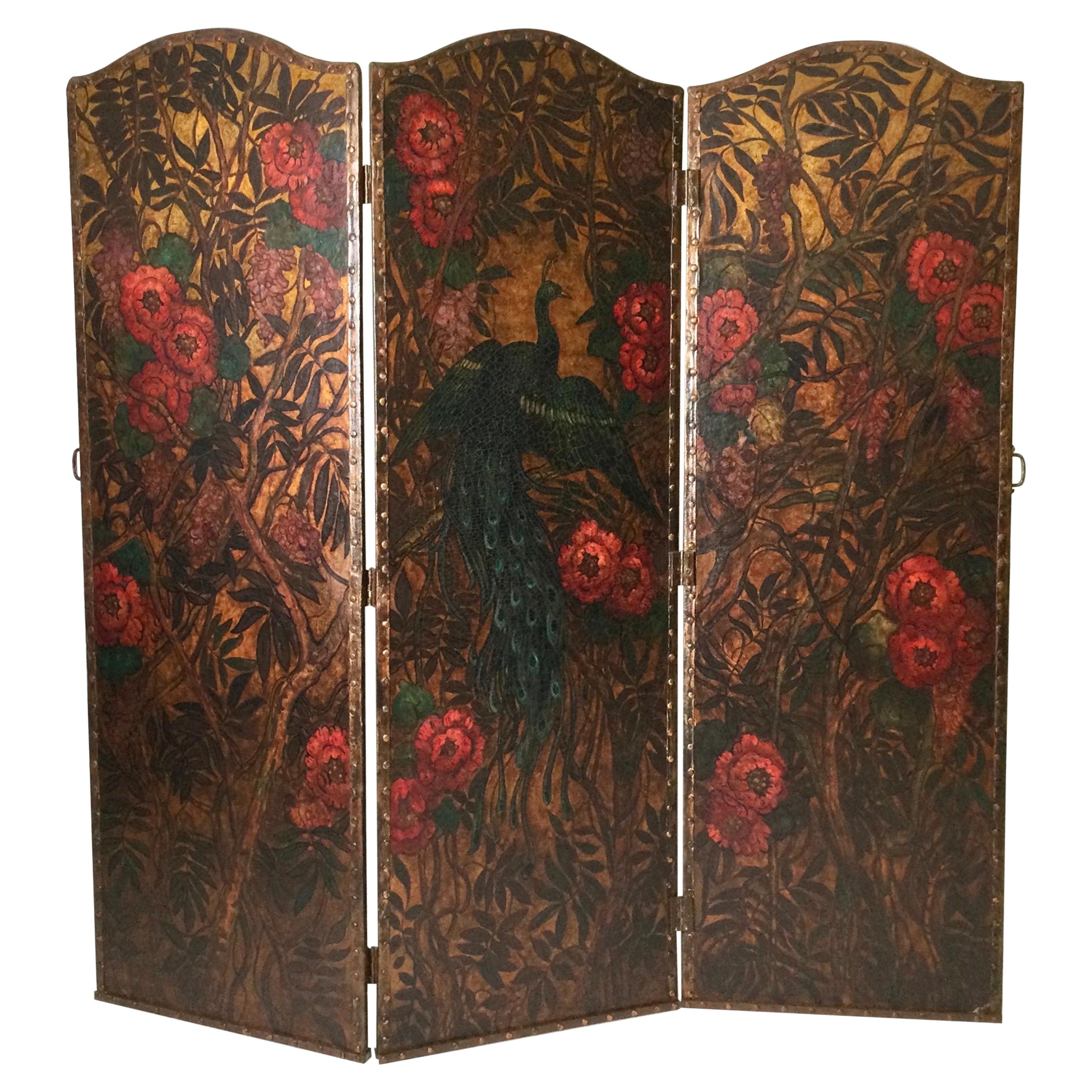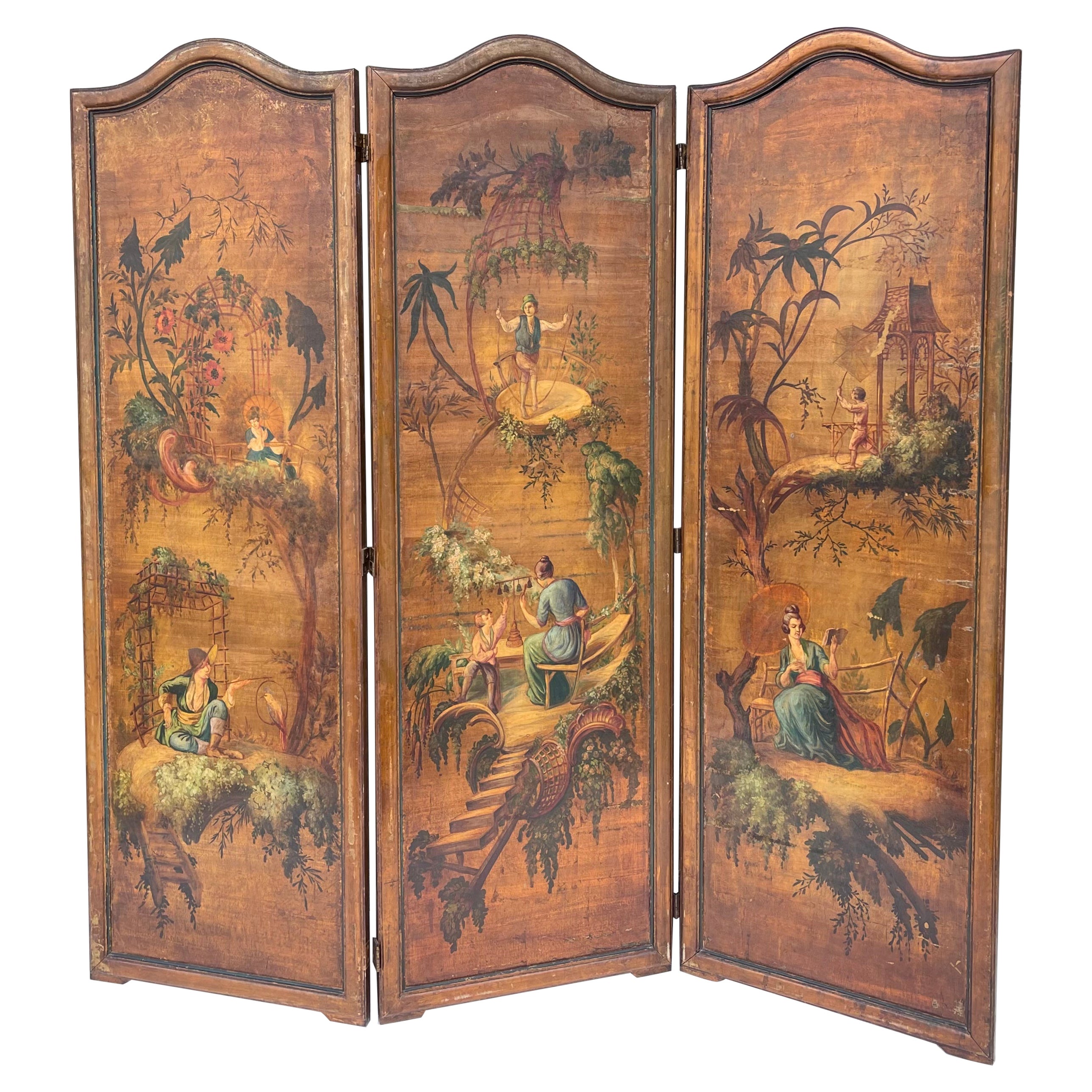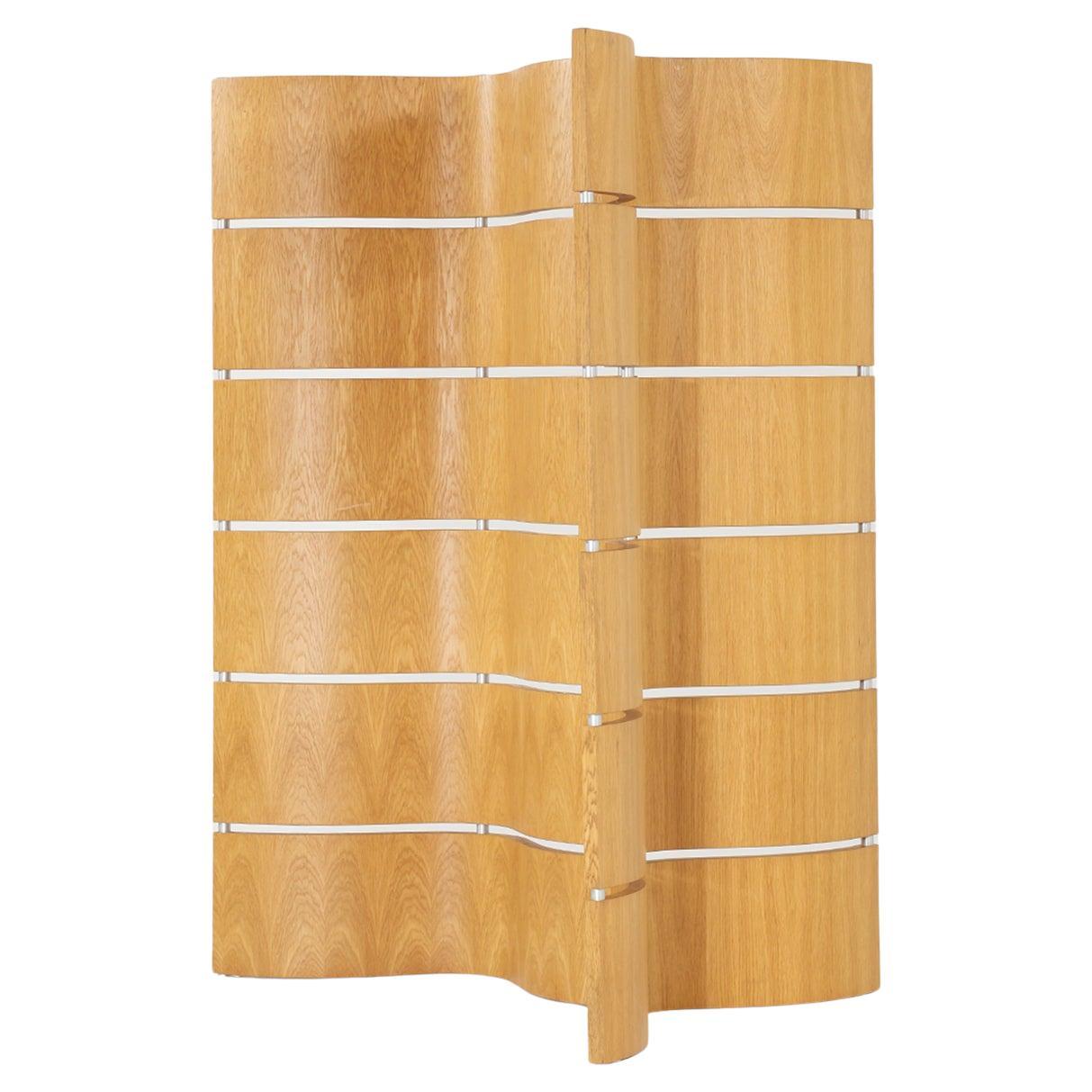Items Similar to 20th Century Oil Painted On Leather Room Screen, c.1920
Want more images or videos?
Request additional images or videos from the seller
1 of 21
20th Century Oil Painted On Leather Room Screen, c.1920
About the Item
Antique 20th Century beautifully painted four panel dress screen depicting 17th Century battleships at sea. Painted oil on leather, each panel is finished with a studded edge.
CONDITION
In Good Condition - Some wear consistent with normal use, please refer to photographs.
SIZE
Height: 81cm
Width: 200cm
Depth: 2.5cm
- Dimensions:Height: 31.89 in (81 cm)Width: 78.75 in (200 cm)Depth: 0.99 in (2.5 cm)
- Materials and Techniques:
- Place of Origin:
- Period:
- Date of Manufacture:circa 1920
- Condition:Wear consistent with age and use. Minor fading. In Good Condition - Some wear consistent with normal use, please refer to photographs.
- Seller Location:Royal Tunbridge Wells, GB
- Reference Number:
About the Seller
5.0
Platinum Seller
These expertly vetted sellers are 1stDibs' most experienced sellers and are rated highest by our customers.
Established in 2014
1stDibs seller since 2015
369 sales on 1stDibs
Typical response time: <1 hour
- ShippingRetrieving quote...Ships From: Sherring, United Kingdom
- Return PolicyA return for this item may be initiated within 14 days of delivery.
More From This SellerView All
- 20th Century Revelation Expanding Leather Suitcase, c.1920Located in Royal Tunbridge Wells, KentAntique early 20th Century Bridle Hide Revelation expanding leather suitcase, a hallmark of innovation from the 1920's, showcased a pioneering design that allowed for adjustable stor...Category
20th Century British Trunks and Luggage
MaterialsBrass
- 20th Century American Leather Briefcase by Hartmann, circa 1920By Hartmann Trunk CompanyLocated in Royal Tunbridge Wells, KentAntique 20th century great example of American luxury luggage maker Hartmann, in soft tan calf skin leather with original features including handle and lock. CONDITION In great c...Category
20th Century American Trunks and Luggage
MaterialsLeather
- 20th Century English Leather Trunk On Metal Stand, c.1910Located in Royal Tunbridge Wells, KentAntique early 20th Century trunk, lined with the original fabric in a champagne colour. This trunk comes with original polished metal locks and leather handles. Applied on the trunk ...Category
20th Century British Trunks and Luggage
MaterialsMetal
- 20th Century English Leather Trunk On Metal Stand, c1910Located in Royal Tunbridge Wells, KentAntique early 20th Century trunk on stand, the inside is lined fabric in a rich burgundy colour, beautifully offsetting the outside natural tan hide colour of the trunk. This trunk c...Category
20th Century British Trunks and Luggage
MaterialsMetal
- 20th Century Louis Vuitton Cow Hide Suitcase, France c.1920By Louis VuittonLocated in Royal Tunbridge Wells, KentA highly unusual and exceptionally rare Louis Vuitton suitcase, originating from the early years of the 20th century, distinguishes itself not with the globally renowned monogram canvas but with a distinctive covering crafted from a singular piece of cowhide. This unique piece represents a special order from Louis Vuitton, showcasing the brand's historical commitment to utilizing only the finest hides available. Unlike many of its counterparts, leather trunks and cases of this era often struggle to withstand the test of time, requiring regular treatments to prevent drying and disintegration. Remarkably, this particular example defies the odds, retaining the same supple quality it possessed on the day it first graced the shop floor. This suitcase belongs to Louis Vuitton's collection of "speciality materials," which encompasses a diverse range, including, but not limited to, zinc, copper, crocodile leather, and cow leather. A brief history about Louis Vuitton trunks: Louis Vuitton was born in 1821 to a farmer and milliner and came from a long-established working-class family in eastern France. Vuitton grew up understanding the effects of perseverance and a strong work ethic from watching his family. At the age of 16, he made the decision to walk 292 miles from his hometown to Paris to try and make a new life for himself. When he arrived the city was in the midst of industrialization with current modes of transportation evolving quickly allowing for longer journeys. With this came the need for sturdy travel pieces. Vuitton was taken as an apprentice for a successful box maker and packer named Monsieur Marechal. He learned to craft durable containers and how to pack them properly – a well-respected profession at the time.In 1854, years after he had mastered his craft and became well respected for it, Vuitton ventured out on his own to open a shop on Rue Neuve des Capucines. It was here that he began to establish himself as a luggage maker. Then, in 1858, Vuitton designed the first Louis Vuitton steamer trunk. At the time trunks had rounded tops to allow for water to run off but this did not allow for convenient stowage. Vuitton introduced a flat, yet waterproof, trunk that was easily stackable. The first of his trunks were outfitted with a grey canvas referred to as Trianon – it wouldn’t be until several decades later that the signature monogram would be introduced. With a burgeoning business, Vuitton moved his family and workplace to Asniere, where he employed twenty workers to craft his trunks. By 1900 he would have 100 employees, and in 1914 the company would more than double in size. After years of success, Vuitton began to experiment with the design of his luggage by introducing a new striped canvas pattern (1876) and later the still well-known Damier print (1888). The hand-painted patterns were developed to prevent counterfeits. Even in the late 1800s, Louis Vuitton was enough of a status symbol to warrant counterfeiting. In 1886, his son George invented and patented an ingenious locking system that made it impossible to pick the lock of their trunks. This lock is still used today. 1892 would prove to be a time of mourning for the family as Louis Vuitton passed...Category
20th Century French Other Trunks and Luggage
MaterialsBrass
- 20th Century Louis Vuitton Cow Hide Suitcase, France c.1920By Louis VuittonLocated in Royal Tunbridge Wells, KentA highly unusual and exceptionally rare Louis Vuitton suitcase, originating from the early years of the 20th century, distinguishes itself not with the globally renowned monogram canvas but with a distinctive covering crafted from a singular piece of cowhide. This unique piece represents a special order from Louis Vuitton, showcasing the brand's historical commitment to utilizing only the finest hides available. Unlike many of its counterparts, leather trunks and cases of this era often struggle to withstand the test of time, requiring regular treatments to prevent drying and disintegration. Remarkably, this particular example defies the odds, retaining the same supple quality it possessed on the day it first graced the shop floor. This suitcase belongs to Louis Vuitton's collection of "speciality materials," which encompasses a diverse range, including, but not limited to, zinc, copper, crocodile leather, and cow leather. A brief history about Louis Vuitton trunks: Louis Vuitton was born in 1821 to a farmer and milliner and came from a long-established working-class family in eastern France. Vuitton grew up understanding the effects of perseverance and a strong work ethic from watching his family. At the age of 16, he made the decision to walk 292 miles from his hometown to Paris to try and make a new life for himself. When he arrived the city was in the midst of industrialization with current modes of transportation evolving quickly allowing for longer journeys. With this came the need for sturdy travel pieces. Vuitton was taken as an apprentice for a successful box maker and packer named Monsieur Marechal. He learned to craft durable containers and how to pack them properly – a well-respected profession at the time.In 1854, years after he had mastered his craft and became well respected for it, Vuitton ventured out on his own to open a shop on Rue Neuve des Capucines. It was here that he began to establish himself as a luggage maker. Then, in 1858, Vuitton designed the first Louis Vuitton steamer trunk. At the time trunks had rounded tops to allow for water to run off but this did not allow for convenient stowage. Vuitton introduced a flat, yet waterproof, trunk that was easily stackable. The first of his trunks were outfitted with a grey canvas referred to as Trianon – it wouldn’t be until several decades later that the signature monogram would be introduced. With a burgeoning business, Vuitton moved his family and workplace to Asniere, where he employed twenty workers to craft his trunks. By 1900 he would have 100 employees, and in 1914 the company would more than double in size. After years of success, Vuitton began to experiment with the design of his luggage by introducing a new striped canvas pattern (1876) and later the still well-known Damier print (1888). The hand-painted patterns were developed to prevent counterfeits. Even in the late 1800s, Louis Vuitton was enough of a status symbol to warrant counterfeiting. In 1886, his son George invented and patented an ingenious locking system that made it impossible to pick the lock of their trunks. This lock is still used today. 1892 would prove to be a time of mourning for the family as Louis Vuitton passed...Category
20th Century French Other Trunks and Luggage
MaterialsBrass
You May Also Like
- Antique Early 20th Century Peacock Screen Hand Painted on LeatherLocated in Lambertville, NJA hand painted early 20th century three panel screen with large peacock and all over floral decoration. The leather panels, signed Emma Long dated 1934. The arched form with antiqued brass nail head...Category
Vintage 1930s American Screens and Room Dividers
MaterialsLeather
- 20th Century Arts & Crafts Folding Screen & Hand Painted Decoration Room DividerLocated in Miami, FLUnique and highly decorative, work of art folding screen. Some will call this amazing and practical size folding screen Arts & Crafts and some will call it Classical Art Nouveau. ...Category
Mid-20th Century Spanish Arts and Crafts Screens and Room Dividers
MaterialsWalnut, Paint
- 20th Century Continental Hand-Painted Oil on Board Four-Fold Floor ScreenLocated in Germantown, MDContinental Hand- Painted Wood Four-Fold Floor Screen. Oil on board fllor screen or room divider. Measures 64" in width and stands 72" tall.Category
20th Century American Modern Screens and Room Dividers
MaterialsWood, Paint
- Early 20th-C. Hand Painted French Chinoiserie Oil On Canvas Screen - 3 PanelsLocated in Kennesaw, GAThis is an early 20th century French hand painted chinoiserie folding screen. It has three panels and looks wonderful mounted on a wall as well. The piece does show some age wear.Category
Early 20th Century European Chinoiserie Screens and Room Dividers
MaterialsPaint, Canvas, Wood
- 20th Century Four Panel Hand Painted ScreenLocated in Miami, FLAn Italian hand painted wood room divider from the 20th century. This antique accordion style folding screen from Italy features 4 connected panels, ...Category
Mid-20th Century Italian Art Nouveau Screens and Room Dividers
MaterialsWood
- 20th Century Danish Mid-Century Modern Birchwood Room Divider - Vintage ScreenLocated in West Palm Beach, FLA sculptural, vintage Mid-Century modern Danish room divider made of hand crafted polished Birchwood, in good condition. The large Scandinavian screen has two adjustable, flexible wa...Category
Mid-20th Century Danish Mid-Century Modern Screens and Room Dividers
MaterialsMetal, Chrome
Recently Viewed
View AllMore Ways To Browse
Vintage Screen Screens And Room Dividers
Vintage Room Screen Screens And Room Dividers
Wooder Screen
Contemporary Room Divider In Natural Cane Webbing
Vintage Asian Silk Dividers Black Lacquer Framed
Antique Glass Fire Screen
Wood Screen Italy
4 Panel Coromandel
Room Divider Italian Folding
Baroli Cartoons
Corrugated Divider
Eames Fsw
Folding Screen Wallpaper
Antique Screen Partition
Eames Plywood Screen
Tambour Divider Screen
Tambour Room Divider Screen
Victorian Embroidered Screen





